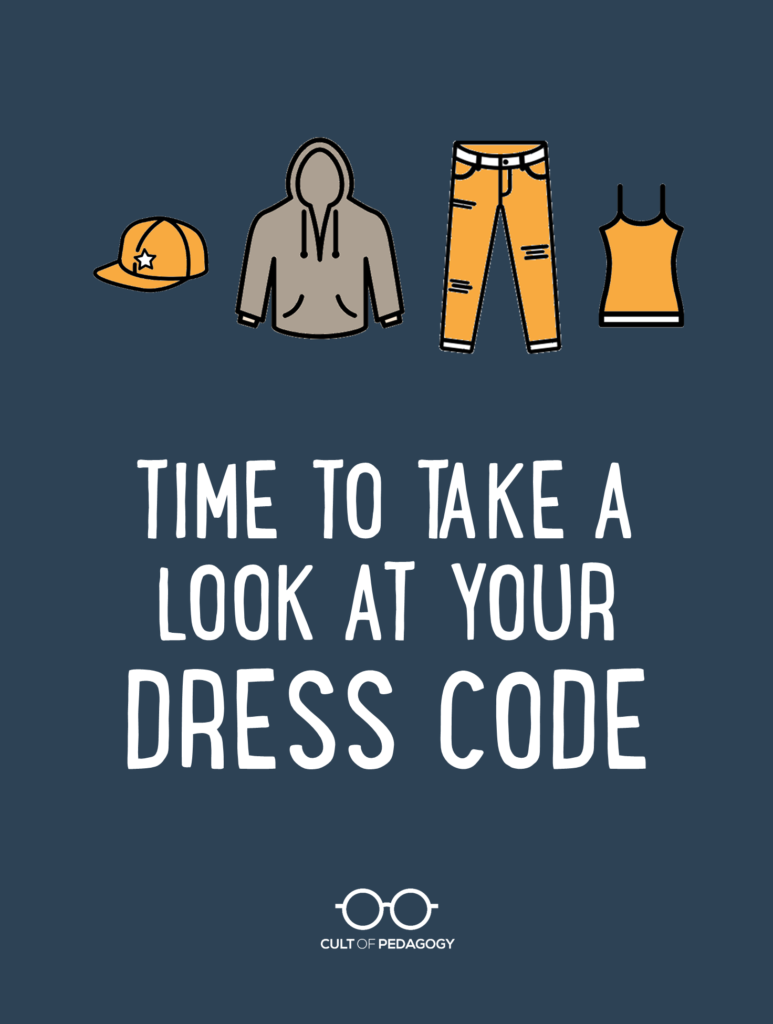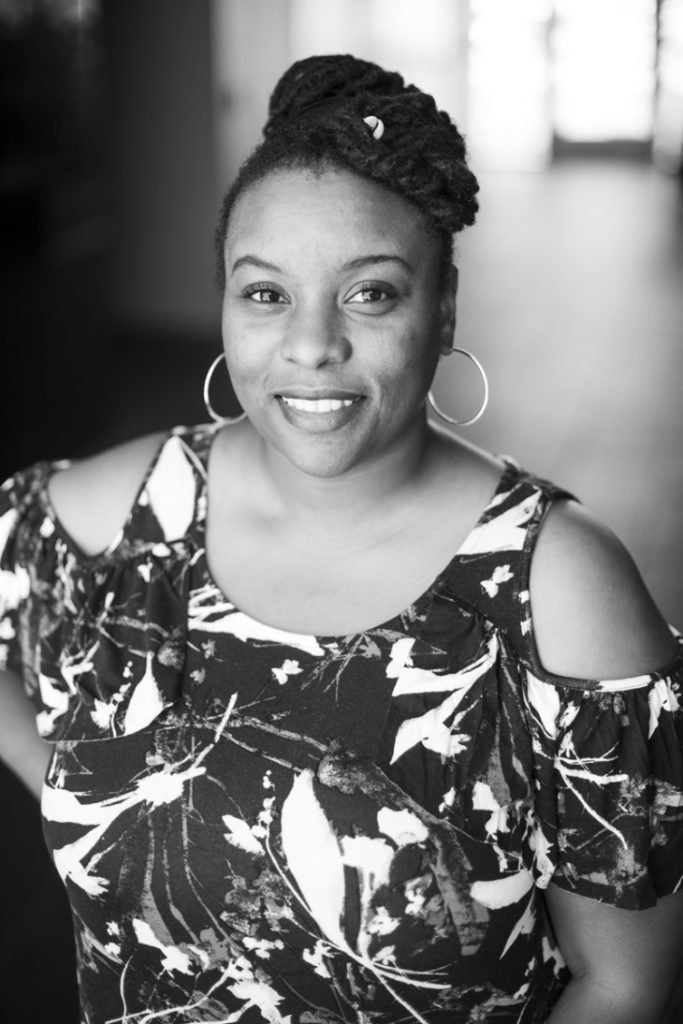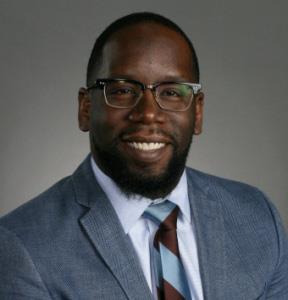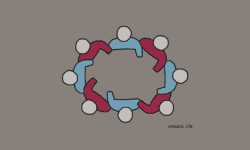
Listen to my interview with Coshandra Dillard
and Marcus Campbell (transcript):
Sponsored by Listenwise and OneNote Class Notebook
A couple months ago, I saw two different news stories that broke my heart. Both were about dreadlocks.
The first story was about Andrew Johnson, a high school wrestler in New Jersey who wore his hair in cheekbone-length dreadlocks. Moments before Johnson was about to go to the mat for a match, the referee told him he wouldn’t be allowed to compete because his hair was too long.
Forced to choose between forfeiting the match for his team or cutting his hair on the spot, Johnson opted for the haircut. In the video taken at the meet, we see Johnson standing stoically while a blond woman takes a large pair of scissors and chops off hunks of his hair, hair that likely took up to a year and hours of maintenance to grow and shape into its current style. With the haircut finished, Johnson took to the mat and won his match.
The video of the incident went viral: Some held up Johnson’s decision as an example of being a team player, while many more expressed outrage and disgust at the referee and all the other adults who let things get as far as they did.
The second story was about Clinton Stanley, Jr., a Florida six-year-old who was turned away at the door on his first day of school because his dreadlocks, which extended below his ears, violated the school’s dress code that required boys’ hair to be cut above their ears and collars.
A photo that looks to have been taken before the incident shows Clinton ready for his first day, eyes shining, a clean, collared shirt pressed and secured with a navy blue necktie, backpack strapped on, red lunchbox in hand. He looks excited, like millions of other kids in their first day of school pictures.
What we see next, in the video taken by his father, is the same child, wearing the same clothes, still carrying his lunchbox, but his eyes are no longer shining. His shoulders sag as he and his father listen to the school staff explain—with a truly disturbing lack of compassion—why he won’t be allowed to start first grade that day.
Dress codes are meant to create safe, positive learning environments in schools, but too many of them have the opposite effect, shaming students, robbing them of instructional time, and disproportionately targeting female students and students of color. The good news is that some schools are stepping up to fix the problem, updating their dress codes to make them more reasonable and equitable.
My hope is that your school will be next in line.
What’s the Problem?
To explore this issue more deeply, I talked with Coshandra Dillard, a writer for Teaching Tolerance who covers equity issues in education, among other things, and wrote about dress codes last year.

Coshandra walked me through some of the most problematic requirements found in many dress codes and helped clarify how they harm kids.
Cultural Discrimination
Students like Johnson and Stanley can find themselves humiliated by dress codes that don’t take cultural differences into consideration. Although this can play out with clothing styles, in recent years it seems to have caused the most trouble with hair.
“We’re basically asking these students to erase who they are in order to get an education,” Dillard explains. “And the policing of black hair, especially with young girls, women, has a long history. You can go back to the 1700s when black women in Louisiana were forced to wear head wraps because these elaborate hairstyles they were wearing were considered a threat to society.”
Many schools defend hair policies by saying their guidelines restrict length, not style. But that defense merely points to another problematic cultural norm: one that insists on boys having short hair.
“What is the issue with the length?” Dillard asks. “Can you give me a real reason…? Is it about safety? How is it distracting? Girls have long hair. Is it because it doesn’t fall into the rules of what a male is supposed to look like?”
Other rules that can do unnecessary harm focus on hats and head coverings. Pushout author Monique Morris explained in our 2016 interview that a girl may be wearing a hat to cover braids that haven’t yet been completed. Given the choice between punishment for keeping the unauthorized hat on and being embarrassed in front of her peers, some girls may choose punishment.
Dillard believes that many of these problems could be avoided with simple relationship building.
“That’s part of being a teacher. Know your community, know your students, ask questions if you don’t understand it, and ensure that everybody feels included and feels valued, because if I’m going in the school and my teacher thinks that I am dirty or that I need to be fixed or that I’m unkempt just because my hair is wild and curly, then I’m going to feel some kind of way, and I’m probably not going to learn in that class.”
Gender Discrimination
One of the most common features of traditional dress codes is language that forbids clothing that shows too much skin, even a student’s collarbone in some cases. While the rules technically apply to all students, they tend to overwhelmingly impact girls.
“If we just police what girls are wearing,” Dillard says, “it implies that the onus is on the girl to prevent any kind of inappropriate behavior from someone else because of what she’s wearing. I’m not sure if schools realize how harmful that is to shame or blame girls for how someone may react rather than addressing that issue in particular. There shouldn’t be inappropriate behavior, period.”
How a student expresses gender can also run up against restrictive dress codes, forcing students to align their appearance with other people’s gender expectations. “Does your dress code require that students’ gender expression match their sex assigned at birth?” Dillard asks. “Do you have different rules for male and female students? Because if you do, then the non-binary students are going to feel left out, they’re going to feel awkward.”
One other issue that falls into this category is menstruation. Requiring light-colored clothing can make it harder for menstruating students to cover leaks. “When administrators include in their policy where everybody wears khaki bottoms, whether it’s a skirt or pants or shorts, people who menstruate may have an accident, and that can cause a problem for the student.”
Economic Discrimination
Schools that require students to have specific types or colors of clothing can make it challenging for some families to comply with the dress code. When updating your policy, keep an eye out for rules that could unfairly target students from low-income homes.
“If you’ve had a coat for two years and it’s green,” Dillard says, “and your school colors are red, a mom may not be able to go out and buy something just so he can be in dress code. At private schools where you have to buy the polo tops that have the emblem or the logo of the school on there, that can be cost prohibitive.”
Case Study: Evanston Township High School
In August of 2017, Evanston Township High School in Evanston, Illinois, made significant revisions to their dress code. Assistant Superintendent and Principal Dr. Marcus Campbell had an instrumental role in that change.

Prior to the change, “Our dress code was rather antiquated,” Campbell says. “It looked similar to the dress codes in high schools of the late ‘80s and ‘90s…some of the restrictions that were in the dress code were no longer available in stores. There were lots of kids in the school who didn’t have the appropriate length of shorts; of course they were appropriate to be out in public, but the school’s dress code was a little bit more conservative and restrictive.”
On top of being impractical, Campbell says, the old dress code at ETHS was not being equitably enforced.
“A lot of our students felt—and I agreed with them—that if certain females were not a certain body type, if they had more curves or they had certain features that were developed, they were dress coded over another young lady who may not have the same features but were wearing the exact same items. Our young women of color were dress coded more than our white girls were.”
“So we found it to be racist, we found it to be sexist, we found it to be antiquated. It was not body positive, and there was just trouble all around with our dress code, and we knew we needed to make a change.”
Campbell and his colleagues were prompted to finally take action when students staged a protest outside the superintendent’s office.
“About 300 kids were out there just sitting. They just decided to stage a sit-in to say, somebody’s got to come out here and talk to us about how ridiculous the dress code is.”
Campbell walked outside and met with students right away. “And sitting and talking to the kids about the dress code,” he says, “there was not one thing I could argue with.”
Over the next several months, Campbell and his colleagues met with student leaders, other administrators, and the school’s discipline committee to draft a new policy for ETHS. Starting with the Model Student Dress Code from the National Organization for Women and the Portland Public Schools in Portland, Oregon, they made some changes to fit their own needs and crafted their own brand-new student dress code, which was formally adopted for the 2017-18 school year.
Since the new guidelines were put in place, Campbell says “absolutely nothing has changed as far as behavior. Students have taken it upon themselves to know what’s decent to wear to school and what is not, and so it’s not like we have kids coming to school in bikinis or anything like that. They’re just comfortable.”
Learn More
If your school is ready to revisit and update your policies for student dress, these excellent resources will help you get started.
About the Issues
DRESS CODED: Black Girls, Bodies, and Bias in D.C. Schools
National Women’s Law Center
This report is specific to D.C. schools, but is applicable everywhere. Offers a thorough overview of the problem and recommendations for revising dress codes. The report also lists guidelines for enforcement. A few of these are so important, I want to note them here:
- Students should never be forced to leave school or the classroom for violating the dress code.
- Schools should require all members of the school community who have the power to enforce the dress code to participate in bias and anti-harassment training at least once a year.
- School police should not be allowed to enforce the dress code.
- Adults should not touch students or their clothing to correct dress code violations, and should not require students to undress in public spaces.
Loc’d Out: How Thoughtless Dress Codes Can Harm Students From Day One
Coshandra Dillard, Teaching Tolerance
How Dress Codes Criminalize Males and Sexualize Females of Color
Alyssa Pavlakis & Rachel Roegman, Phi Delta Kappan
Guidelines for Improved Policies and Practices
Student Dress Code
Evanston Township High School, Evanston, IL
An excellent model of a revised, inclusive dress code. It’s specific enough to avoid loose interpretation but broad enough to allow for a lot of student choice. Lists freedoms along with restrictions, and includes language prohibiting discrimination on the basis of race, religion, gender, gender expression, and sexual orientation.
Model Student Dress Code
National Organization for Women and Portland Public Schools, Portland, OR
Best Practices for Serving LGBTQ Students
Teaching Tolerance
Includes guidelines for LGBTQ-inclusive dress codes.
Code of Conduct: A Guide to Responsive Discipline
Teaching Tolerance
Join our mailing list and get weekly tips, tools, and inspiration that will make your teaching more effective and fun. You’ll get access to our members-only library of free downloads, including 20 Ways to Cut Your Grading Time in Half, the e-booklet that has helped thousands of teachers save time on grading. Over 50,000 teachers have already joined—come on in.





Just yesterday I was having a conversation with my stylist about “dreadlocks.” She educated me on the negative connotation of the term. After listening to the podcast, I wanted to share the information.
http://affinitymagazine.us/2017/01/14/why-you-should-be-careful-saying-dreads/
Dr. L. Clark,
Thank you so much for sharing this information. This complements the article shared in Jenn’s post written by her podcast guest, Coshandra Dillard.
I follow Baltimore educator Valencia Clay on Instagram and recently watched one of her videos where she shared the origins of the term “dreadlocs” and explained that historically, locs were called “dreadful” by white people. As a white educator, I work to use culturally relevant language, and it seems as though “locs” is the correct term to use.
I wish our school would change their dress code — it is still the old fashioned one that focuses on saggy pants and bare midriffs. And, of course, most of the prohibitions are about what girls wear.
I strongly want to change our dress code. However, after hearing these stories I am horrified by the whole thing. I want all of our student to exhibit a sense of pride, but our society has become one that is not proud of anything. Kids have not only isolated themselves with technology, but now we are allowing them to what I term “turtle” indie their sweat shirts instead of standing tall and embracing confidence. And it’s not because of a bad haircut. The students I have asked to please remove their hoods are more or less seeming to want to avoid everyone and be in their own world all the time. I don;t feel this is good. Encouraging/ allowing children to hide from the world is not doing anything to prepare them for the real world. It may seem minor, but as a parent, would you want to see almost have a class wearing hoods in your child’s class picture? Would you want your child to feel that every time things get challenging they can just hid to make it all disappear. This is not a fashion statement. It’s an excuse. Now don’t get me wrong. I am a teacher of color and I fully understand about messed up or unfinished hair, or the occasion need to be in one’s own space, but these kids are wearing this hoods all day! My own teenager thought she could do that at home!!!
Thank you for sharing this information and new perspectives. It caused me to think about a number of things I had never considered.
I often wonder how ‘catching’ students violating the dress code can take up more time, space, and attention than calling out students’ thinking, creativity, and contributions to the larger community.
I agree with this so much! At our school, we currently exclude students from class if they are out of uniform, but I wonder about the message that sends. I’ve been thinking about what a better solution might be- I worry that if the consequence is lessoned we will have more students out of uniform as a result.
This podcast popped up on my phone for some reason. I listen to podcasts but not generally ones on education (I did when my kids were in school many years ago though). My first thought was this must be a replay of a 50 year old podcast until I remembered they didn’t have podcasts 50 years ago. I cannot believe there has been a public school in the country with a dress code that limited the length of boy’s hair since the 1970s. Long hair on men/boys was controversial in the 1960s but by the 1970s Nixon and Regan supporters had long hair. Private schools might be a different story. But when you choose to go to a private school you are not just buying an education but also buying into a specific philosophy and culture. If it doesn’t match with your philosophy and ethics go to a different private school. I suspect if I was as rich as Bill Gates I won’t send my kids to most private schools because I disagree with their philosophy of education and ethics. I suspect that is true for most people.
In 1968 I moved from northern VA to the SF Bay area. I was in 8th grade. It was a real culture shock. Public schools in northern VA had strict dress codes and most students were fashion conscious. When I moved to CA it was jeans, t-shirts and flip-flops. I don’t remember there being any dress codes. There were no dress codes when my kids went to public schools in Oakland. They tried briefly in the early 2000s, mostly because of gangs and discipline problems in the schools but it didn’t take hold. It could be I live in a bubble (which I do) but if this podcast was on public schools you must have cherry picked the only schools left with a dress code.
sorry for the long rant. Though the podcast seemed totally out of touch with education in the Bay Area it may prompt me to may try a few more. I’m not an educator but I have had a long interest in education.
I guess I come at the dress code argument from a completely different angle. I believe that part of our job in in schools is to prepare our students for jobs and life outside of school so I believe that students should wear clothing that would be appropriate in a public or job related environment. When I looked at the Evanston dress code, I was shocked to see that pajamas were listed on the “may wear” list partly because I can’t think of any job that would allow workers to wear pajamas. The dress code at my school has changed over the years to be less geared toward the girls and more toward a general description of appropriate dress but pajamas are still not allowed. Maybe that’s coming? I hope not…
I’m super curious to hear more about hat policies! At my school we have a no-hats-in-the-halls policy because some of the teachers let students wear hats and the others don’t. It’s been really polarizing because the no-hat teachers insist it is a safety issue and the others don’t agree.
Our school has revised our dress code policy over the years to more positively reflect our diverse population, so I appreciate Jenn’s focus on this topic. I am thankful for my superintendent who is always willing to carry an open mind when something in our policy is challenged and make revisions when the original intent and purpose no longer meets our population’s needs.
I disagree with the first story of the student having to cut his dreadlocks in order to wrestle being used as an example of an dress code policy needing change. Jenn’s statement of the purpose of dress codes is first to create a safe environment. There are reasons that, even in my limited understanding of the wrestling sport, I can imagine why having longer hair can be a serious safety hazard in such a close contact sport. I only want to make the point that while there are certainly reasons for rewriting dress code policies, some that have been in affect for a long time do still carry a very important purpose.
Wow – thank you for sharing this store Jenn. I still have goose bumps and great sadness over the little boy on his first day of school. I always feel that as teachers and school community, we can really make or break a child’s relationship with school by how accepted and valued they feel as part of that community. As a former Kindergarten teacher, I believe that the role of the teacher in a child’s first few years is to help that child fall in love with the journey of learning and inspire their natural curiosity. Dress codes, as a whole, do not honor learners and their backgrounds, beliefs, etc.
We recently re-evaluated our school dress code and have ultimately updated it to reflect that learners need to be comfortable and able to move in their attire in a variety of environments. The dress code is the same for all genders and does not differentiate based on cultural background. This new dress code values differences in learners and works to support them as members of our community.
Again, thanks for sharing!
Roberta
Really appreciate you sharing this, Roberta. The conversations need to keep happening.
I’m cis male of mixed Western & Southern European ancestry. I’m also not a fan of dress codes but we are, ostensibly, educating students for future careers, especially white collar, professional careers (my opinion on the “all students must go to college” meme so popular in schools today is not printable), and the dress code should be targeted to dressing the students for the careers we supposedly want them to enter.
On a related topic, one school I worked in forbade students from wearing, among other things, flip-flops. but teachers weren’t so constrained. A fairly basic dress code concern should be that dress codes for students should not be more stringent than they are for faculty.
Also related is that I’ve spoken to students about dress code enforcement, and male students have pretty consistently said male teachers are terrible about calling out girls on dress code violations, but female teachers have no such qualms about boys’ violations, possibly because girls’ dress codes are more subjective, especially with regards to modesty issues.
As to hair? Why would anyone care about dreadlocks, braids, or color?
Thank you for sharing these stories, Jennifer. I cannot imagine having to give up a huge part of my identity in order to win a wrestling match, or attend my first day of school.
I am currently a student teaching intern at an urban school in a low income community. All but three of the students at this school are African American. This is a new public school, but there are certain aspects of the school that make it feel like a charter school. For instance, there is a strict school dress code. The students must wear a navy polo and dark blue or khaki pants or skirts each day. Students are allowed to wear shoes of their choosing and any hairstyle they want, but they are given strict allowances on sweaters and hoodies. Specifically, students are not allowed to wear hoodies, and if they want to wear a sweater, it must be a cardigan. While I am very glad that the students are allowed and encouraged to wear their hair however they like and can show off their style with shoes and fanny packs, I was shocked to learn last week that the students could be sent home for school dress code violations. If students come to school not meeting dress code, their guardian must come provide them with a change of clothes as soon as possible. Many of the students in this school walk to school, and their guardians are busy working during the day. This makes it unlikely that the students would have a person available to come bring them a change of clothes. I asked what would be done in the case that a student would not have a person available to come bring them a change of clothes, and the response was that they would be sent home. Not only does this take away from time learning in the classroom, but in addition, what message does this communicate to our students? Is there a suggestion I could make to prevent this from happening?
Hey Katie, if you check out the Code of Conduct link at the bottom of the post, you’ll find a link to the PDF document. In section 1 of this Code of Conduct document, you’ll find a school self-assessment on disciplinary practices. This is a tool you might consider bringing to your administration with the goal of reflecting on how your school can find alternatives to sending kids home. We can agree that it is in the students’ best interest to stay in the classroom where learning is taking place. Finding creative alternatives might even include having extra sets of clothing on hand that students can use if they’re in violation of the dress code, so they can stay in class. Regardless, I think the ideas listed in this resource will help you set a course of personal action that hopefully will improve the situation at your school.
Thank you for all of your ideas, Eric! This is an excellent plan and meaningful way to address these issues with the administration. I will bring this to them next week!
I love the Cult of Pedagogy podcast, but I felt this episode did not fairly address both sides the debate. Please read the interesting article below and consider having Dr. Sax as a guest on your program.
https://www.psychologytoday.com/us/blog/sax-sex/201711/who-is-distracted-girl-wearing-skintight-leggings
I agree that most parts of most dress codes (hair length, caps, hoodies, etc) and silly and unnecessary. I believe that anything that targets a particular race is wrong. However, I think a majority of parents still believe that some standard of modesty in school still matters, so it is unfair to present their views as straw men. Unfortunately, it is really difficult to know where (and how) to draw the line (at spandex daisey dukes and tube tops? or at thong bikinis?).
Since modesty is so subjective to define and even more subjective to enforce, I really think basic uniforms really are the best and simplest option. The idea that uniforms have to be expensive is a straw man. Schools can buy dark slacks and polo shirts in bulk for $12 each and provide them to students at a low price (and free to low-income families). No fancy logo is needed on the shirts. The research cited by Dr. Sax shows that students would perform much better on exams in these comfortable modest uniforms than they would in leggings.
I find it very telling how every example article of clothing you mentioned was feminine.
I accept that aspect of our responsibilities in schools is to set up our understudies for occupations and life outside of school so I accept that understudies should wear attire that would be suitable in an open or employment-related condition. The clothing standard at my school has changed throughout the years to be less designed for the young ladies and more toward an overall depiction of the suitable dress however nightgowns are still not permitted.
Thank you, thank you, thank you. Thank you for writing the article, but more importantly thank you for doing due diligence and backing up your stance with statements and research from nationally recognized agencies. That, and the resources explicitly listed in the article will make it much easier for me to lobby my school and/or school board (next year – we have other problems this year).
I appreciate that the principal in Evanston realized that he had no good arguments against the students requests for a change in dress code. I felt, for the first time ever, that I was “seen”. I seem to be the only person in my school who thinks our dress code serves no purpose, and that dress-coding someone is very damaging. How a person dresses is the most personal and usually the most truthful expression of themselves. Telling them the have made the wrong choice in clothing is tantamount to telling them they’re bad people. It is utterly hypocritical to require teachers to create “safe spaces” for students and evaluate them on their ability to create “welcoming classroom environments” then require that they interrupt someone’s education by humiliating them in front of their peers for a personal choice.
Off my soap box now. I’m very grateful for this piece.
So glad you found it helpful, Johanna!
What about the inequity male educators are faced with when female students accuse those teachers of looking at students inappropriately while enforcing dress code standards? This has happened to several male educators I know.
This has everything to do with the fact that dress codes are majority of the time about sexualizing and covering the young girl’s body. Therefore, when a male educator calls out a dress code violation, that puts them in the position of looking at the young students inappropriately. The dress code does sexualize students which makes this unavoidable when having one.
I was crying while reading this I think all schools should read this article because all teens need freedom to wear what they want to express themselves. I think not letting them express themselves would make them like robots who live in a society that’s all the same.